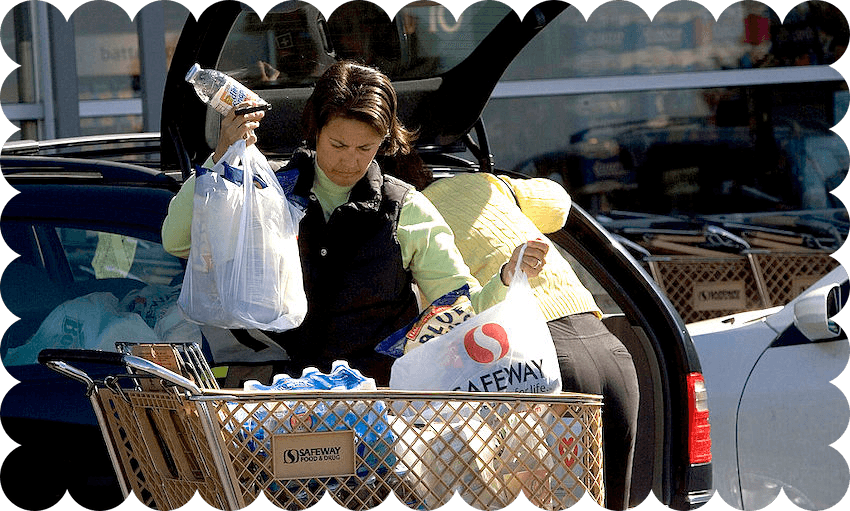Attempting to be more sustainable at this time of year can feel like a losing battle. But at least we’re trying, writes Emma Ricketts.
It’s time to dig out the Christmas decorations, untangle the lights and ignite the barbecue. It’s the season for work parties, family gatherings and dessert stomachs.
It is also the season to be reminded to celebrate sustainably. Every year around this time our feeds are inundated with waste-free ways to wrap presents and reminders to avoid the plastic plate aisle at the supermarket. But as the inevitable stress of this hectic season bears upon us, it is easy to lose the sustainable spirit.
Will it really matter if I buy some disposable plates? It would save me having to wash every one in my kitchen. Between 2019 and 2021 Coca-Cola increased its use of newly made plastic by almost 100,000 metric tons – how can a pack of 12 plates compare?
It’s so much quicker to pick up wrapping paper at the supermarket than rifle through my recycling for something to parcel my presents in. Is it worth the effort, when the US produces more than 3.5 times the plastic waste per capita than OECD countries in Oceania?
Earlier this year, I experienced my own crisis of conscious over these questions.
Living in New Zealand, I took pride in trying to reduce my environmental footprint as much as possible. I took notice of the most common items in my rubbish bin and replaced them with reusable options. I carried my keep cup everywhere. I ate my lunch off plates and cutlery provided by my office. I avoided printing unless it was an absolute necessity.
Then six months ago, I moved to the US and was immediately confronted by that country’s voracious demand for single-use plastic.
New Zealanders throw away an estimated 159 grams of plastic per day. We are currently one of the top 10 per-capita producers of landfill waste in the world.
Americans, on the other hand, produced approximately 385 grams of plastic waste per day in 2021, according to a report authored by Beyond Plastics and Last Beach Cleanup. During holiday periods, this can increase by up to 25%.
Reading these figures was one thing; but seeing the prevalence of disposable plastic in real life has floored me.
Here in Washington DC I am yet to see a keep cup used in a cafe. While their absence may be partially attributable to the pandemic, a 2019 survey found that 63% of Americans stated they would never use a reusable cup when buying coffee.
The office where I study only offers disposable cups, plates and cutlery for people to use. Takeaway lunch options invariably come in single-use containers. Disposable water bottles are common, particularly at events.
While New Zealand has phased out single-use shopping bags, they’re still readily accessible here. A five-cent fee does little to deter shoppers from using them.
This is not to say that New Zealand is perfect – we have a long way to go. New Zealand’s recycling facilities fall far short of the plastic waste we produce, and an estimated 252,000 tonnes of plastic is dumped in landfills each year. But taking individual steps to reduce my footprint felt far more accessible when I was at home. It felt like I was moving with the current as we all tried to be a little less wasteful; here, it’s like swimming against the tide.
Holiday season is already underway in the US. Halloween and Thanksgiving are behind us, and Christmas is fast approaching.
I am yet to be confronted with reminders to reduce, reuse and recycle during the festive season. Instead, the holidays seem to provide endless opportunities to market single-use goods.
Halloween, unsurprisingly, is supported enthusiastically by confectionery companies. Chocolates and lollies that usually come wrapped in a single large piece of plastic are made smaller. These are wrapped in several smaller pieces of plastic, which in turn is sold inside a larger piece of plastic. And on top of that – as any New Zealander who’s visited the US knows – the chocolate doesn’t even taste that good.
Then there’s Thanksgiving which, like Christmas, is a time for social gatherings and indulgence. The uptick in cooking leads to longer supermarket lists, and an increase in the packaging that comes with it.
For those opting for convenience, disposable plates, cups and utensils are marketed as vital time-savers. Pre-made food comes in hard-to-recycle plastic and polystyrene containers, some of which would be banned under New Zealand’s latest plastic regulations.
Seeing the amount of single-use plastic used here, it’s easy to question whether there’s any point in New Zealand, whose population is just 1.5% of the United States’, even trying to be more sustainable.
Our government has pledged to phase out many single-use plastic products by 2025, including tableware, straws and PVC packaging. But what difference will that make when Americans are said to use 500 million straws a day?
Once I got over my initial despair, I landed on a more hopeful note.
The problem of plastic pollution can only be solved with teamwork. It may feel like a mammoth, insurmountable task, but we have to start somewhere.
In New Zealand, we already have the messaging down. There is no shortage of reminders to be mindful with shopping, wrapping gifts and preparing food this Christmas.
From what I have witnessed, New Zealand has experienced a cultural shift that has not yet reached the US. Carrying your keep cup and trusty Sistema to buy takeaway coffees and lunches is widely considered a normal thing to do. Most businesses happily oblige.
The ban on single-use plastic shopping bags in 2019 prompted some grumbling, but reusable quickly became the norm.
It is rare to see a fridge in New Zealand filled with disposable bottles of water. Reusable drink bottles come in colours that are way more fun.
We aren’t perfect, but my time away from home has led me to appreciate the progress that New Zealanders have made. I’m looking forward to returning home one day and rediscovering my lower-plastic habits. With Christmas just around the corner, it’s a good time to remember that our achievements matter, and they are something to be proud of.
In the meantime, I’ll keep bringing my own cutlery to the office here in DC – and missing the hand-warming benefits of a coffee in a glass keep cup.

